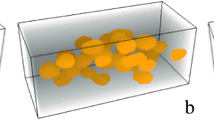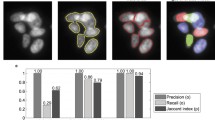Abstract
Determining the number and morphology of individual cells on microscopy images is one of the most fundamental steps in quantitative biological image analysis. Cultured cells used in genetic perturbation and drug discovery experiments can pile up and nuclei can touch or even grow on top of each other. Similarly, in tissue sections cell nuclei can be very close and touch each other as well. This makes single cell nuclei detection extremely challenging using current segmentation methods, such as classical edge- and threshold-based methods that can only detect separate objects, and they fail to separate touching ones. The pipeline we present here can segment individual cell nuclei by splitting touching ones. The two-step approach merely based on energy minimization principles using an active contour framework. In a presegmentation phase we use a local region data term with strong edge tracking capability, while in the splitting phase we introduce a higher-order active contour model. This model prefers high curvature contour locations at the opposite side of joint objects grow “cutting arms” that evolve to one another until they split objects. Synthetic and real experiments show the strong segmentation and splitting ability of the proposed pipeline and that it outperforms currently used segmentation models.
Access this chapter
Tax calculation will be finalised at checkout
Purchases are for personal use only
Similar content being viewed by others
Notes
- 1.
Extended by the charge conservation principle.
- 2.
Hence the negative sign.
References
Boykov, Y., Kolmogorov, V.: Computing geodesics and minimal surfaces via graph cuts. In: ICCV, pp. 26–33. IEEE (2003)
Caselles, V., Kimmel, R., Sapiro, G.: Geodesic active contours. IJCV 22(1), 61–79 (1997)
Chan, T., Vese, L.: An active contour model without edges. In: Nielsen, M., Johansen, P., Olsen, O.F., Weickert, J. (eds.) Scale-Space 1999. LNCS, vol. 1682, pp. 141–151. Springer, Heidelberg (1999). doi:10.1007/3-540-48236-9_13
Chan, T., Vese, L.: A multiphase level set framework for image segmentation using the Mumford and Shah model. IJCV 50(3), 271–293 (2002)
Chang, H., Yang, Q., Parvin, B.: Segmentation of heterogeneous blob objects through voting and level set formulation. Pattern Recogn. Lett. 28(13), 1781–1787 (2007)
Daněk, O., Matula, P., Ortiz-de-Solórzano, C., Muñoz-Barrutia, A., Maška, M., Kozubek, M.: Segmentation of touching cell nuclei using a two-stage graph cut model. In: Salberg, A.-B., Hardeberg, J.Y., Jenssen, R. (eds.) SCIA 2009. LNCS, vol. 5575, pp. 410–419. Springer, Heidelberg (2009). doi:10.1007/978-3-642-02230-2_42
Faugeras, O., Keriven, R.: Variational principles, surface evolution, pdes, level set methods, and the stereo problem. Trans. Img. Proc. 7(3), 336–344 (1998)
He, Y., Gong, H., Xiong, B., Xu, X., Li, A., Jiang, T., Sun, Q., Wang, S., Luo, Q., Chen, S.: iCut: an integrative cut algorithm enables accurate segmentation of touching cells. Sci. Rep., 5, (2015). Article no. 12089
Jiang, T., Yang, F.: An evolutionary tabu search for cell image segmentation. IEEE Trans. Syst. Man Cybern. Part B Cybern. 32(5), 675–678 (2002)
Jones, T.R., Carpenter, A., Golland, P.: Voronoi-based segmentation of cells on image manifolds. In: Liu, Y., Jiang, T., Zhang, C. (eds.) CVBIA 2005. LNCS, vol. 3765, pp. 535–543. Springer, Heidelberg (2005). doi:10.1007/11569541_54
Kenong, W., Gauthier, D., Levine, M.D.: Live cell image segmentation. IEEE Trans. Biomed. Eng. 42(1), 1–12 (1995)
Kothari, S., Chaudry, Q., Wang, M.D.: Automated cell counting and cluster segmentation using concavity detection and ellipse fitting techniques. In: IEEE ISBI, pp. 795–798. IEEE (2009)
Kumar, S., Ong, S.H., Ranganath, S., Ong, T.C., Chew, F.T.: A rule-based approach for robust clump splitting. Pattern Recogn. 39(6), 1088–1098 (2006)
Lehmussola, A., Ruusuvuori, P., Selinummi, J., Huttunen, H., Yli-Harja, O.: Computational framework for simulating fluorescence microscope images with cell populations. IEEE Trans. Med. Imaging 26(7), 1010–1016 (2007)
Li, G., Liu, T., Nie, J., Guo, L., Chen, J., Zhu, J., Xia, W., Mara, A., Holley, S., Wong, S.: Segmentation of touching cell nuclei using gradient flow tracking. J. Microsc. 231(1), 47–58 (2008)
Molnar, C., Jermyn, I.H., Kato, Z., Rahkama, V., Östling, P., Mikkonen, P., Pietiäinen, V., Horvath, P.: Accurate morphology preserving segmentation of overlapping cells based on active contours. Sci. Rep. 6, 1–10 (2016). Article no. 32412 EP
Molnar, J., Szucs, A.I., Molnar, C., Horvath, P.: Active contours for selective object segmentation. In: 2016 IEEE Winter Conference on Applications of Computer Vision (WACV), pp. 1–9 (2016)
Pinidiyaarachchi, A., Wählby, C.: Seeded watersheds for combined segmentation and tracking of cells. In: Roli, F., Vitulano, S. (eds.) ICIAP 2005. LNCS, vol. 3617, pp. 336–343. Springer, Heidelberg (2005). doi:10.1007/11553595_41
Qi, X., Xing, F., Foran, D.J., Yang, L.: Robust segmentation of overlapping cells in histopathology specimens using parallel seed detection and repulsive level set. IEEE Trans. Biomed. Eng. 59(3), 754–765 (2012)
Shi, J., Malik, J.: Normalized cuts, image segmentation. IEEE Trans. Pattern Anal. Mach. Intell. 22(8), 888–905 (2000)
Smith, K., Li, Y., Piccinini, F., Csucs, G., Balazs, C., Bevilacqua, A., Horvath, P.: CIDRE: an illumination-correction method for optical microscopy. Nature Methods 12(5), 404–406 (2015)
Wienert, S., Heim, D., Saeger, K., Stenzinger, A., Beil, M., Hufnagl, P., Dietel, M., Denkert, C., Klauschen, F.: Detection and segmentation of cell nuclei in virtual microscopy images: a minimum-model approach. Sci. Rep. 2, 503 (2012). 22787560
Yang, Q., Parvin, B.: Harmonic cut and regularized centroid transform for localization of subcellular structures. IEEE Trans. Biomed. Eng. 50(4), 469–475 (2003)
Author information
Authors and Affiliations
Corresponding author
Editor information
Editors and Affiliations
Appendix
Appendix
The derivation of the Euler-Lagrange equation associated to functional (2) is straightforward albeit long. Here we only provide the result. The notations used in the equations are the following: the point at contour parameter t is designated by position vector \(\mathbf {r}\left( t\right) \). The bound variable of the integrals is denoted by \(\tau \), hence the invariant arc length: \(ds=\left| \dot{\mathbf {r}}\right| d\tau \) (the derivatives of the position vector w.r.t. the contour parameter are denoted by dots: \(\dot{\mathbf {r}},\,\mathbf {\ddot{r}}\ldots \)). The unit tangent and normal vectors of the contour are denoted by \(\mathbf {e},\,\mathbf {n}\), where \(\mathbf {e}=\frac{\dot{\mathbf {r}}}{\left| \dot{\mathbf {r}}\right| }\). Using right handed coordinate system, they are related with \(\mathbf {n}=\mathbf {k}\times \mathbf {e}\), where \(\mathbf {k}\) is the normal of the image plane, hence the contour normals point inward. The (signed) curvature of the contour is given by \(\kappa =\frac{\mathbf {\ddot{r}}\cdot \mathbf {n}}{\left| \mathbf {\dot{r}}\right| ^{2}}\). The unit direction vector between points given by contour parameters t and \(\tau \) is denoted by \(\mathbf {e}_{t\tau }=\frac{\mathbf {r}_{\tau }-\mathbf {r}_{t}}{d_{t\tau }}\), where \(d_{t\tau }=\left| \mathbf {r}_{\tau }-\mathbf {r}_{t}\right| \) is their Euclidean distance. We also use the normal to this direction vector with definition \(\mathbf {n}_{t\tau }=\mathbf {k}\times \mathbf {e}_{t\tau }\). The alignment between contour points is defined by \(a_{t\tau }\doteq \mathbf {n}\left( t\right) \cdot \mathbf {e}_{t\tau }+\mathbf {n}\left( \tau \right) \cdot \mathbf {e}_{\tau t}\) (\(\mathbf {e}_{\tau t}=-\mathbf {e}_{t\tau }\)). \(f,\,g,\,l\) are the appropriately chosen functions of the curvature, alignment and distance respectively, for their derivatives we use prime mark \(f^{\prime },\,f^{\prime \prime }\ldots \) The first and second derivatives of the curvature w.r.t. the arc length are denoted by \(\frac{d\kappa }{ds},\,\frac{d^{2}\kappa }{ds^{2}}\). The curvature and its derivative are scalars. Note that the derivative w.r.t. the arc lenght of any scalar quantity q can be calculated on the planar grid using the formula: \(\left( \nabla q\right) \cdot \mathbf {e}\), where \(\nabla \) is the gradient operator with components being the partial derivatives \(\left( \frac{\partial }{\partial x},\frac{\partial }{\partial y}\right) \) w.r.t. image coordinates \(x,\,y\).
The formula: \(A=\mathbf {e}_{t\tau }\cdot \left( \mathbf {e}\left( t\right) -\mathbf {e}\left( \tau \right) \right) \), \(B=\mathbf {e}_{t\tau }\cdot \left( \mathbf {n}\left( t\right) -\mathbf {n}\left( \tau \right) \right) \),\(C=\left[ \frac{l\left( d_{t\tau }\right) }{d_{t\tau }}-l^{\prime }\left( d_{t\tau }\right) \right] \), \(D=\mathbf {e}_{t\tau }\cdot \mathbf {n}\left( t\right) \), \(E=\mathbf {e}_{t\tau }\cdot \mathbf {e}\left( t\right) \), \(F=\mathbf {n}\left( \tau \right) \cdot \mathbf {e}\left( t\right) \) are introduced to simplify the equation. The Euler-Lagrange equation associated to the half of (2) at point t has the form \(\left| \dot{\mathbf {r}\left( t\right) }\right| Q\mathbf {n}\left( t\right) =\mathbf {0}\), where Q is given by the following sum:
The factors outside the integrals are calculated at parameter t (i.e. independent of the bound variable). Note that any factor depending only on parameter t, could be brought before the integrals, but would lead more complicated expression.
Rights and permissions
Copyright information
© 2016 Springer International Publishing AG
About this paper
Cite this paper
Molnar, J., Molnar, C., Horvath, P. (2016). An Object Splitting Model Using Higher-Order Active Contours for Single-Cell Segmentation. In: Bebis, G., et al. Advances in Visual Computing. ISVC 2016. Lecture Notes in Computer Science(), vol 10072. Springer, Cham. https://doi.org/10.1007/978-3-319-50835-1_3
Download citation
DOI: https://doi.org/10.1007/978-3-319-50835-1_3
Published:
Publisher Name: Springer, Cham
Print ISBN: 978-3-319-50834-4
Online ISBN: 978-3-319-50835-1
eBook Packages: Computer ScienceComputer Science (R0)




